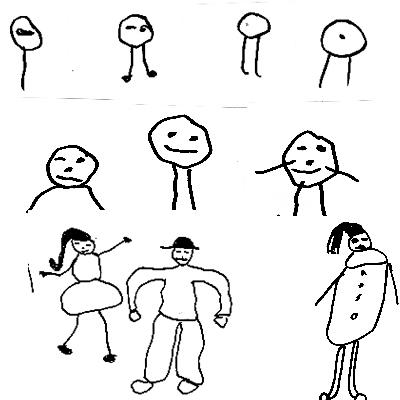
How is my child's man's drawing evolves?
From what age does a child begin to draw men?
"For the greatest number of children, it all starts around 3 years old, with the circle.It is already a concept of the body image that he begins to make of him, "said Edwige Antier, pediatrician and author of the book" My healthy child "at Editions Eyrolles.The child will gradually add two features for the arms and two features for the legs, "this is the 'man-tastard'", she said.
How does the man evolve over time?
"Around 4 years old, the child separates the head from the body by superimposing two rounds.The arms see fingers bloom, but the number is not correct.The eyes enter the upper circle, large well -wide eyes.This is why the child has so much empathy with Mickey, his big head, his eyes wide open, and his hands with fourdoigts ", enlightens Edwige Antier.Around 5 years old, the child begins to draw the neck to separate the head from the body."The mouth arrives soon after with a more or less smiling line.The hair will distinguish a girl from a boy, "said the pediatrician before clarifying:" Little boys tend to draw a line between the legs.He is aware of his sex ".The feet start to camp the character.At only 6 years old, the child draws precisely five fingers on each hand.It was later that he will draw a character in profile.
What makes the child improve?
"The awareness that he gradually acquires self.The child takes time to feel separated from the mother.In the first months, the infant thinks he is one with his mom.The breast he heads is a part of him.Besides, if he sucks as he starts to speak, he says: 'My breast'!Mom's belly, her breasts: everything is round, it's round.Come his eyes, with this look that scans his environment to understand the messages.Little by little, he designs taking the objects with his hands, moving with his legs, then speaking with his mouth, then writing with his fingers ... ", indicates Edwige Antier.
You have to help the child, guide him, show him how to draw a guy?

"You can make your own drawings with the child on his knees by telling him stories.It will tell him but not teach him.Because that will not influence its own graphics, which is programmed like walking or teeth! ", Advises the pediatrician.
Are there any reasons to worry if the drawing is struggling to evolve?
"Having a figure traced according to the model can help check that the child has acquired the concepts of his age (on average the round at 3 years old, the square at 4 years, the diamond at 6 years old).The drawn of the guy is more complex because he is also governed by emotions.I find it a shame to display the drawings of children in class, or to offer them on a cloth, with the first name of each, because it leads to completely unsuitable comparisons and judgments on the part of parents! ", She considers.
Should we ask him questions?Make him tell a story from his drawing?
"Do not ask questions, this is an awkward Inquisition because the child does not know what you expect, and that disturbs him.No way to make him tell him a story, we must leave the imagination of the free child of your reactions, "said Edwige Antier."At the same time, avoid reacting by saying 'it's very beautiful!', While you think of something else.A drawing is an offering that deserves his interest: 'He has a big belly, it looks like he ate well?'.Can you also ask him if his guy 'is happy today?'.
Will a child who make "beautiful guys" will necessarily be better in drawing than others?
For Edwige Antier, the answer is clear: "Absolutely not.Drawing is the expression of an emotion.Yesterday a little girl seeing drawings stuck on the wall of my office said to me: 'I do not draw;My sister draws well! '.I showed him a self-portrait of Picasso and said to him: "You find him beautiful, this drawing?", "No", she replied.So I showed him the Picasso maternity painting and I asked him again "and that one?".She replied "yes, very beautiful".So, I explained to him that it was the same painter, that the whole world loved his car portrait because it is the emotion that a drawing transmits.This is why I always tell children when I teach them a sheet: 'I love failed drawings!' "
Book: My healthy child of Dr Edwige Antier and Marie Dewavrin by Eyrolles editions.Available here.







